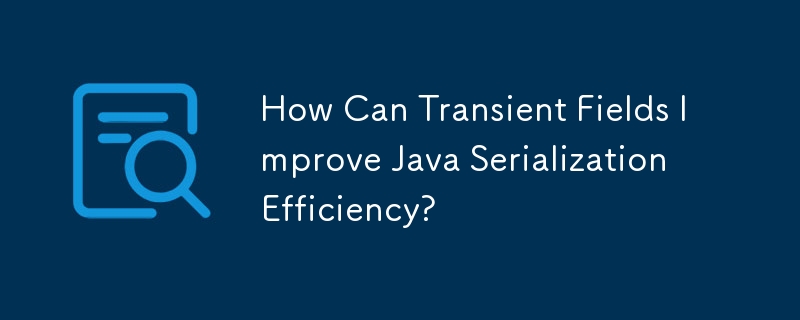How Can Transient Fields Improve Java Serialization Efficiency?
Dec 17, 2024 pm 05:05 PM
Taming Transient Fields in Java: A Key to Efficient Serialization
In Java's rich tapestry of data structures, the transient keyword emerges as an essential tool for crafting objects destined for serialization. But why the need for such power? Let's delve into the realm of transient fields and explore their purpose and intricacies.
Transient Elixir: Preventing Excess Serialization
Serialization, the process of converting an object's state into a storable format, often involves preserving every field of that object. However, there are scenarios where certain fields should remain untouched during this process. Transient fields provide the solution.
By annotating a field as transient, you instruct Java to exclude it from the serialization process. This prevents the field's value from being stored along with the object's persistent state. It's particularly useful for fields that are either derived from other fields or intended for temporary storage, rather than being part of the object's immutable identity.
Practical Example: GalleryImage and Its Transient Thumbnail
Consider a GalleryImage class that encapsulates an image and its thumbnail. While the original image needs to be saved, the thumbnail can be easily regenerated programmatically. Using a transient field for the thumbnail ensures that only the original image is serialized, saving storage space.
class GalleryImage implements Serializable {
private Image image; private transient Image thumbnailImage;
}
Deserialization and Transient Fields
Deserialization, the process of reconstructing an object from its serialized form, requires special handling for transient fields. Since these fields were not serialized, they must be restored manually after deserialization. This can be achieved by overriding the readObject method and explicitly regenerating the transient fields.
class GalleryImage implements Serializable {
// ...
private void readObject(ObjectInputStream inputStream)
throws IOException, ClassNotFoundException {
inputStream.defaultReadObject();
generateThumbnail();
}}
Additional Resources:
For further insights into transient fields, consider exploring:
- Java Language Specification: https://docs.oracle.com/javase/specs/jls/se7/html/jls-8.html#jls-8.3.1.3
- Discover the secrets of the Java Serialization API: https://www.javaworld.com/article/2077206/learn-java/discover-the-secrets-of-the-java-serialization-api.html
The above is the detailed content of How Can Transient Fields Improve Java Serialization Efficiency?. For more information, please follow other related articles on the PHP Chinese website!

Hot tools Tags

Hot Article

Hot tools Tags

Notepad++7.3.1
Easy-to-use and free code editor

SublimeText3 Chinese version
Chinese version, very easy to use

Zend Studio 13.0.1
Powerful PHP integrated development environment

Dreamweaver CS6
Visual web development tools

SublimeText3 Mac version
God-level code editing software (SublimeText3)

Hot Topics
 How does Java's classloading mechanism work, including different classloaders and their delegation models?
Mar 17, 2025 pm 05:35 PM
How does Java's classloading mechanism work, including different classloaders and their delegation models?
Mar 17, 2025 pm 05:35 PM
How does Java's classloading mechanism work, including different classloaders and their delegation models?
 How do I use Maven or Gradle for advanced Java project management, build automation, and dependency resolution?
Mar 17, 2025 pm 05:46 PM
How do I use Maven or Gradle for advanced Java project management, build automation, and dependency resolution?
Mar 17, 2025 pm 05:46 PM
How do I use Maven or Gradle for advanced Java project management, build automation, and dependency resolution?
 Top 4 JavaScript Frameworks in 2025: React, Angular, Vue, Svelte
Mar 07, 2025 pm 06:09 PM
Top 4 JavaScript Frameworks in 2025: React, Angular, Vue, Svelte
Mar 07, 2025 pm 06:09 PM
Top 4 JavaScript Frameworks in 2025: React, Angular, Vue, Svelte
 How can I implement functional programming techniques in Java?
Mar 11, 2025 pm 05:51 PM
How can I implement functional programming techniques in Java?
Mar 11, 2025 pm 05:51 PM
How can I implement functional programming techniques in Java?
 Iceberg: The Future of Data Lake Tables
Mar 07, 2025 pm 06:31 PM
Iceberg: The Future of Data Lake Tables
Mar 07, 2025 pm 06:31 PM
Iceberg: The Future of Data Lake Tables
 How can I use JPA (Java Persistence API) for object-relational mapping with advanced features like caching and lazy loading?
Mar 17, 2025 pm 05:43 PM
How can I use JPA (Java Persistence API) for object-relational mapping with advanced features like caching and lazy loading?
Mar 17, 2025 pm 05:43 PM
How can I use JPA (Java Persistence API) for object-relational mapping with advanced features like caching and lazy loading?
 How do I implement multi-level caching in Java applications using libraries like Caffeine or Guava Cache?
Mar 17, 2025 pm 05:44 PM
How do I implement multi-level caching in Java applications using libraries like Caffeine or Guava Cache?
Mar 17, 2025 pm 05:44 PM
How do I implement multi-level caching in Java applications using libraries like Caffeine or Guava Cache?
 How do I use Java's NIO (New Input/Output) API for non-blocking I/O?
Mar 11, 2025 pm 05:51 PM
How do I use Java's NIO (New Input/Output) API for non-blocking I/O?
Mar 11, 2025 pm 05:51 PM
How do I use Java's NIO (New Input/Output) API for non-blocking I/O?







